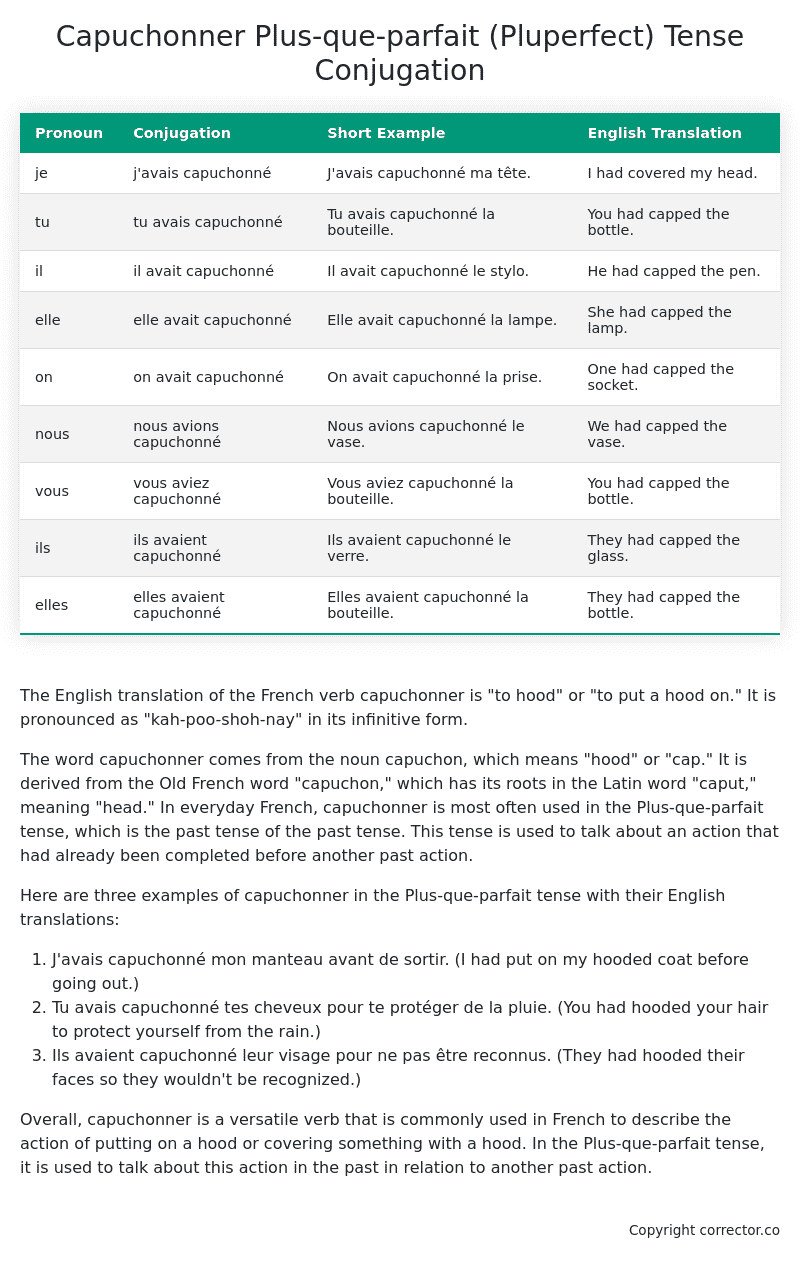Plus-que-parfait (Pluperfect) Tense Conjugation of the French Verb capuchonner
Introduction to the verb capuchonner
The English translation of the French verb capuchonner is “to hood” or “to put a hood on.” It is pronounced as “kah-poo-shoh-nay” in its infinitive form.
The word capuchonner comes from the noun capuchon, which means “hood” or “cap.” It is derived from the Old French word “capuchon,” which has its roots in the Latin word “caput,” meaning “head.” In everyday French, capuchonner is most often used in the Plus-que-parfait tense, which is the past tense of the past tense. This tense is used to talk about an action that had already been completed before another past action.
Here are three examples of capuchonner in the Plus-que-parfait tense with their English translations:
- J’avais capuchonné mon manteau avant de sortir. (I had put on my hooded coat before going out.)
- Tu avais capuchonné tes cheveux pour te protéger de la pluie. (You had hooded your hair to protect yourself from the rain.)
- Ils avaient capuchonné leur visage pour ne pas être reconnus. (They had hooded their faces so they wouldn’t be recognized.)
Overall, capuchonner is a versatile verb that is commonly used in French to describe the action of putting on a hood or covering something with a hood. In the Plus-que-parfait tense, it is used to talk about this action in the past in relation to another past action.
Table of the Plus-que-parfait (Pluperfect) Tense Conjugation of capuchonner
| Pronoun | Conjugation | Short Example | English Translation |
|---|---|---|---|
| je | j’avais capuchonné | J’avais capuchonné ma tête. | I had covered my head. |
| tu | tu avais capuchonné | Tu avais capuchonné la bouteille. | You had capped the bottle. |
| il | il avait capuchonné | Il avait capuchonné le stylo. | He had capped the pen. |
| elle | elle avait capuchonné | Elle avait capuchonné la lampe. | She had capped the lamp. |
| on | on avait capuchonné | On avait capuchonné la prise. | One had capped the socket. |
| nous | nous avions capuchonné | Nous avions capuchonné le vase. | We had capped the vase. |
| vous | vous aviez capuchonné | Vous aviez capuchonné la bouteille. | You had capped the bottle. |
| ils | ils avaient capuchonné | Ils avaient capuchonné le verre. | They had capped the glass. |
| elles | elles avaient capuchonné | Elles avaient capuchonné la bouteille. | They had capped the bottle. |
Other Conjugations for Capuchonner.
Le Present (Present Tense) Conjugation of the French Verb capuchonner
Imparfait (Imperfect) Tense Conjugation of the French Verb capuchonner
Passé Simple (Simple Past) Tense Conjugation of the French Verb capuchonner
Passé Composé (Present Perfect) Tense Conjugation of the French Verb capuchonner
Futur Simple (Simple Future) Tense Conjugation of the French Verb capuchonner
Futur Proche (Near Future) Tense Conjugation of the French Verb capuchonner
Plus-que-parfait (Pluperfect) Tense Conjugation of the French Verb capuchonner (this article)
Passé Antérieur (Past Anterior) Tense Conjugation of the French Verb capuchonner
Futur Antérieur (Future Anterior) Tense Conjugation of the French Verb capuchonner
Subjonctif Présent (Subjunctive Present) Tense Conjugation of the French Verb capuchonner
Subjonctif Passé (Subjunctive Past) Tense Conjugation of the French Verb capuchonner
Subjonctif Imparfait (Subjunctive Imperfect) Tense Conjugation of the French Verb capuchonner
Conditionnel Présent (Conditional Present) Tense Conjugation of the French Verb capuchonner
Conditionnel Passé (Conditional Past) Tense Conjugation of the French Verb capuchonner
L’impératif Présent (Imperative Present) Tense Conjugation of the French Verb capuchonner
L’infinitif Présent (Infinitive Present) Tense Conjugation of the French Verb capuchonner
Struggling with French verbs or the language in general? Why not use our free French Grammar Checker – no registration required!
Get a FREE Download Study Sheet of this Conjugation 🔥
Simply right click the image below, click “save image” and get your free reference for the capuchonner Plus-que-parfait tense conjugation!

Capuchonner – About the French Plus-que-parfait (Pluperfect) Tense
Tense Formation
Common everyday usage patterns
Sequencing of past events
Background information
Hypothetical or reported speech
Interactions with other tenses
Summary
I hope you enjoyed this article on the verb capuchonner. Still in a learning mood? Check out another TOTALLY random French verb conjugation!


